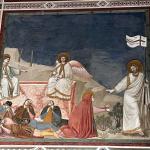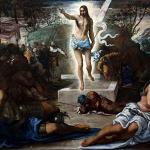Here are some notes for a lecture I’m presenting on March 24:
Death Penalty in the Mosaic Law and Today
INTRODUCTION
The Mosaic law establishes the death penalty for a number of crimes. Not every violation of the 10 commandments was a capital crime (theft, for instance, required restitution), but the death penalty is given for some form of nearly all the 10 commandments (like much of what follows, this chart is drawn, with modifications, from an essay by James Jordan):
Command Sin forbidden Capital form of sin Reference
1st Idolatry Enticement to idolatry Deut 13:1-10; 17:2-5
3rd Blasphemy Blasphemy Lev 24:11-16
4th Sabbath Sabbath violation Ex 31:14-15; 35:2
5th Dissing parents Rebellion son Deut 21:18-21; Ex 21:17
6th Murder Premeditated murder Ex 21:12-14
7th Adultery Various sexual crimes Lev 20
8th Theft Manstealing Ex 21:16
9th False witness Perjury in capital case Deut 19:15-21
This is not an exhaustive list, but gives some idea of the range of capital crimes in the OT law. To us in the modern West, this appears to be a large number of capital crimes, but historically it is actually a fairly short list. During certain periods of English history, for instance, hundreds of crimes were punished by death (for a darkly humorous description of 18th-century capital crimes in England, see Dickens, A Tale of Two Cities , Book 2, chapter 1).
Several preliminary points must be made about this. First, we have to remember that this is the Word of God. Christians cannot pretend that these passages do not exist, or simply ignore them, nor can we let modern sentimentality determine our evaluation of these texts. If they seem harsh to us, the problem may well be ours. Second, this is specifically the Word of our Creator and Redeemer, the same God who sent His Son to take the capital crime in our place, the same God who sends rain on the just and the unjust, the same God who says ?turn the other cheek.?E So, we cannot say that these laws are ?unreasonably harsh?Ewithout saying God is unreasonably harsh. Which is a lie. Third, the basic purpose and meaning of the Mosaic law is not to provide blueprints for a civil order, but to provide foreshadowings of Jesus Christ. Our main framework for understanding the Mosaic system and applying it in our day is typological. The Mosaic system provides both types and shadows of Jesus (He is the Priest, the Sacrifice, the Tabernacle, etc.) and typological patterns for the life of the church, the totus Christus (cf. 1 Cor 9:9, 13). Fourth, the common ordering of the Mosaic law into ?moral, civil, ceremonial,?Ewhile valid in a broad sense, does not give must assistance in dealing with specific passages. In the law, moral, civil, and ceremonial features are all mixed up together.
THE DEATH PENALTY IN ANCIENT ISRAEL
Examining the significance of the death penalty in ancient Israel involves two aspects: first, we want to examine some details about how the death penalty actually was carried out in ancient Israel. Second, we want to ask, what is the rationale for the death penalty in the Mosaic law?
How did the death penalty function? First, the death penalty was the penalty on the books for various crimes, but it was not a mandatory penalty for most crimes. Numbers 35 is about the institution of cities of refuge for those who committed manslaughter. Verses 30-31 read, ?If anyone kills a person, the murderer shall by put to death at the evidence of witnesses, but no person shall be put to death on the testimony of one witness. Moreover, you shall not take ransom for the life of a murderer who is guilty of death, but he shall surely be put to death.?E This makes it clear that convicted murderers had to be executed, but also implies that the penalty in other crimes might be commuted through a ransom, probably some monetary compensation (see Prov 6:32-35; Matt 1:19). Just as God accepted the blood of a sacrificed animal in place of the blood of the sinner, so also the victim of a crime other than murder might accept a lesser penalty than death. Also, when someone confessed to a high-handed sin, God mercifully treated the sin as an inadvertent sin that could be atoned for by sacrifice (Num 5:5-8); so also, God?s representatives, the human ?gods?Ewho governed Israel, might commute a sentence for a penitent criminal (other than a murderer).
Second, the death penalty was carried out only after a trial, only through due process. Stoning was not a mob action (but it could be, cf. Acts 7). When a man-slayer came to a city of refuge, for instance, ?the congregation judged between the slayer and the blood avenger?Eto determine whether or not the man-slayer was a murderer (Num 35:22-28). No one could be convicted except by the testimony of two or three witnesses (Deut 17:6; 19:15-21). This means that the commandment to execute a ?man who lies with a man?E(Lev 20:13) cannot be interpreted as ?you shall stone homosexuals.?E Rather, it meant that someone convicted by the testimony of witnesses of committing sodomy might be executed (though it was not mandatory that he should be).
THE THEOLOGY OF THE DEATH PENALTY
The death penalty is an essential, foundational principle of biblical theology. Adam was told in the Garden, ?from the tree of the knowledge of good and evil you shall not eat, for in the day that you eat from it you shall surely die?E(Gen 2:17). Here we see the first example of the commutation of a capital sentence: Instead of putting Adam to death, Yahweh, based on the sacrifice of a substitute, imposed a less severe form of death, namely, exile from the tree of life. But ?dying you shall die?Ewas still the fundamental curse against sinful humanity. Israel?s worship was entirely based on the justice of the death penalty, because their entire worship center on the slaughter of representative, substitutionary animals. Ultimately, this was the curse that Jesus accepted on behalf of His people. When we are saved, we are rescued from that threat. Denying the justice of the death penalty undermines the whole structure of biblical redemption.
But the story of Adam raises a theological issue that is essential for understanding the death penalty in the Mosaic system and how the OT capital crimes might apply today. Adam, after all, was threatened with death for eating fruit! Talk about harsh! Even the Mosaic law doesn?t prescribe the death penalty for eating forbidden food; if an Israelite ate unclean meat, he had to wash his clothes and would remain unclean until evening (Lev 11:40). Why would God threaten death for such a minor infraction?
Before trying to answer that question, we should note that we have similar threats in the Mosaic system. When Israel assembled at Sinai, Yahweh said that anyone who touched the ?border of the mountain?Ewould be put to death (Ex 19:12). Once the tabernacle was set up, any non-priest who tried to enter the Holy Place or Most Holy Place was to be executed (Num 1:51; 3:10, 38). Stepping on the wrong ground could get you killed.
To understand this, we have to consider the holiness structure of ancient Israel. Israel was set up as a system of graded holiness, which applied at several levels. Spatially, the most holy place was the Most Holy Place; the Holy Place was somewhat less holy, and the courtyard of the tabernacle less holy still; the land of Israel was more holy than surrounding lands, but not so holy as the tabernacle. Personally, the High Priest was holier than the other priests, but the priests were holier than the people, and Israelites holier than the Gentiles. The holiness of places, persons, and things was determined by their nearness to God, who is Thrice Holy.
With regard to the death penalty: The pattern is that the nearer one is to Yahweh, and the holier one?s status, the more severe the penalties. Adam was in the g
arden where Yahweh walked, and so even a ?minor?Esin received the death penalty; the Priests were near to God, so rearranging the order of the sacrifice was enough to get Hophni and Phineas killed ?Eit was a ?great sin?E a priest?s daughter who ??played the harlot?Ewas executed and burned (Lev 21:9; the burning, probably, was done with altar fire), but a layman?s daughter who played the harlot might be executed by stoning; Israelites lived in the holy land, the land Yahweh claimed and the land where He lived, and therefore they were subject to more severe penalties than the nations.
Interestingly, we can even see shifts within the Mosaic revelation in regard to the severity of penalties. As noted above, anyone who touched Mount Sinai was executed. Later, the tabernacle is set up as a kind of ?portable Sinai,?Ea traveling architectural representation of God?s holy mountain. But Israelites are NOT forbidden to touch the tabernacle, and in fact they are free to enter the courtyard to bring sacrifices. How is this possible? The difference is that Yahweh has erected curtain barriers to keep Israel at some distance from His holy presence. Priests can?t go into the ?cloud?Ethe way Moses did, because God has erected the tabernacle as a screen between Himself and His people, for their protection. But that protection means that the sentence of death is not carried out with the same severity or intensity as when Israel saw Yahweh ?unveiled?Eat Sinai.
DEATH PENALTY IN THE NEW COVENANT
Given the OT revelation of the importance of the death penalty, and faced with rising crime and stupid laws, some Christian writers in the last few decades have suggested that the OT system of law should be transferred, in toto, to modern nations. This includes the death penalties, which, some have argued, are still ?binding?Eon modern nations. The above analysis raises insurmountable problems for this view: first, because capital punishment was not ?binding?Ein every case even for Israel, and, most importantly, because the death penalty in the Mosaic law functioned within the system of holiness that no longer exists. We could make this kind of totality transfer only if there were a nation that was in the same ?holy?Estatus as Israel. But there is no such nation in the NC (other than the church ?Esee below). As the church has recognized for most of her history, the Mosaic law is still instructive, and is, together with the rest of Scripture, the basis for Christian political and legal practice
Is the death penalty still a just civil punishment? In principle, it is for murder, particularly since the death penalty for murder was first presented to Noah, and is not specifically Mosaic (Gen 9:5-7). It is a law for all descendants of Noah, not merely for Israel. Beyond that, I do not believe that we have the wisdom to know how far other Mosaic capital punishments should be applied today. I?m sympathetic to the recent call for a moratorium on the death penalty, though for somewhat different reasons than are usually given. We live in a society where the right to kill one?s unborn baby is guaranteed as a part of the fundamental right to choose one?s own understanding of reality. This is an easy case, and until we can distinguish between helpless victims who require the protection of the law and criminals who deserve execution, we have too little wisdom to exercise any authority in hard cases of life and death. Conservatives who worry that a moratorium on the death penalty would open the floodgates of crime sound a lot like political Judaizers, who believe that righteousness can be established by law.
We lack the wisdom to apply Moses in the civil sphere because we have failed to apply the Mosaic where we should and can. The Mosaic system was a system for the holy community of Yahweh, and that holy community is now the church. And the Mosaic system, because it was fundamentally about Christ, was also fundamentally about the order of the church, the body of Christ. In particular, the death penalties of the Mosaic system apply to those who are ?nearest?Eto God, that is, those who are priests in the temple of the Spirit, who have been brought near. They apply in the church.
This is the way Paul uses the death penalty formula in 1 Cor 5. He is dealing with a sexual sin that was a capital crime in ancient Israel (1 Cor 5:1; Lev 20:11), and he uses a phrase from Deuteronomy that refers to ?purging?Ean offender through execution (1 Cor 5:13; cf. Deut 13:5; 17:7; 21:21; 22:21). Yet, Paul is not referring to execution, but to exclusion from the church. The sinner in Corinth is the be delivered to Satan (1 Cor 5:5). This doesn?t mean that he is eternally damned, which is not a decision the Corinthians could make. It means he?s turned out of the church, back into the world under the dominion of the accuser. This is a severe penalty, in reality far more severe than the death penalty. But it is also a merciful discipline, which intends to destroy the ?flesh?Eso that the ?spirit?Ecan be saved in the end (?flesh?Eand ?spirit?Eare not two parts of the person, but the two ages of history that the sinner is trying to straddle).
Thus, the death penalty crimes from the Mosaic law apply in the NC as ground for excommunication. All the qualifications that we made above need to be brought in here: all things must be established by witnesses, the penalty of excommunication is not mandatory, if an offender confesses and repents he will be forgiven, etc. Thus, churches don?t excommunicate ?homosexuals,?Ebut do excommunicate those who are proven to have committed acts of sodomy and refuse to repent; churches don?t excommunicate ?disobedient children,?Ebut might well excommunicate a juvenile delinquent who makes his parents?Ehome hell with his addictions and violence; churches don?t excommunicate someone who smiles on the Sabbath, but might well disciple a member who works his employees 24/7 or one who uses some position of authority to abuse the poor.















